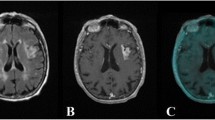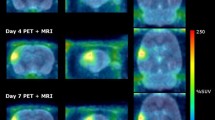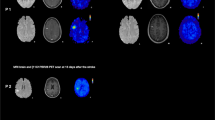Abstract
Purpose
The purpose of this study is to evaluate the 18 kDa translocator protein (TSPO) radioligand [18F]N-fluoroacetyl-N-(2,5-dimethoxybenzyl)-2-phenoxyaniline ([18F]PBR06) as a positron emission tomography (PET) imaging biomarker of stroke-induced neuroinflammation in a rodent model.
Procedures
Stroke was induced by transient middle cerebral artery occlusion in Balb/c mice. Dynamic PET/CT imaging with displacement and preblocking using PK111195 was performed 3 days later. PET data were correlated with immunohistochemistry (IHC) for the activated microglial markers TSPO and CD68 and with autoradiography.
Results
[18F]PBR06 accumulation peaked within the first 5 min postinjection, then decreased gradually, remaining significantly higher in infarct compared to noninfarct regions. Displacement or preblocking with PK11195 eliminated the difference in [18F]PBR06 uptake between infarct and noninfarct regions. Autoradiography and IHC correlated well spatially with uptake on PET.
Conclusions
[18F]PBR06 PET specifically images TSPO in microglial neuroinflammation in a mouse model of stroke and shows promise for imaging and monitoring microglial activation/neuroinflammation in other disease models.






Similar content being viewed by others
References
Wang Q, Tang XN, Yenari MA (2007) The inflammatory response in stroke. J Neuroimmunol 184:53–68
Milner R (2009) Microglial expression of alphavbeta3 and alphavbeta5 integrins is regulated by cytokines and the extracellular matrix: beta5 integrin null microglia show no defects in adhesion or MMP-9 expression on vitronectin. Glia 57:714–723
Coull BM (2007) Inflammation and stroke—introduction. Stroke 38:631–631
Weinstein JR, Koerner IP, Moller T (2010) Microglia in ischemic brain injury. Future Neurol 5:227–246
Papadopoulos V, Baraldi M, Guilarte TR et al (2006) Translocator protein (18 kDa): new nomenclature for the peripheral-type benzodiazepine receptor based on its structure and molecular function. Trends Pharmacol Sci 27:402–409
Rupprecht R, Papadopoulos V, Rammes G et al (2010) Translocator protein (18 kDa) (TSPO) as a therapeutic target for neurological and psychiatric disorders. Nat Rev Drug Discov 9:971–988
Cagnin A, Kassiou M, Meikle SR, Banati RB (2007) Positron emission tomography imaging of neuroinflammation. Neurotherapeutics 4:443–452
Fujimura Y, Hwang PM, Trout Iii H et al (2008) Increased peripheral benzodiazepine receptors in arterial plaque of patients with atherosclerosis: an autoradiographic study with [(3)H]PK 11195. Atherosclerosis 201:108–111
Fujimura Y, Ikoma Y, Yasuno F et al (2006) Quantitative analyses of 18F-FEDAA1106 binding to peripheral benzodiazepine receptors in living human brain. J Nucl Med 47:43–50
Gerhard A, Neumaier B, Elitok E et al (2000) In vivo imaging of activated microglia using [11C]PK11195 and positron emission tomography in patients after ischemic stroke. Neuroreport 11:2957–2960
James ML, Fulton RR, Henderson DJ et al (2005) Synthesis and in vivo evaluation of a novel peripheral benzodiazepine receptor PET radioligand. Bioorg Med Chem 13:6188–6194
Imaizumi M, Kim HJ, Zoghbi SS et al (2007) PET imaging with [11C]PBR28 can localize and quantify upregulated peripheral benzodiazepine receptors associated with cerebral ischemia in rat. Neurosci Lett 411:200–205
James ML, Fulton RR, Vercoullie J et al (2008) DPA-714, a new translocator protein-specific ligand: synthesis, radiofluorination, and pharmacologic characterization. J Nucl Med 49:814–822
Yui J, Maeda J, Kumata K et al (2010) 18F-FEAC and 18F-FEDAC: PET of the monkey brain and imaging of translocator protein (18 kDa) in the infarcted rat brain. J Nucl Med 51:1301–1309
Yui J, Hatori A, Kawamura K et al (2011) Visualization of early infarction in rat brain after ischemia using a translocator protein (18 kDa) PET ligand [11C]DAC with ultra-high specific activity. Neuroimage 54:123–130
Ikoma Y, Yasuno F, Ito H et al (2007) Quantitative analysis for estimating binding potential of the peripheral benzodiazepine receptor with [11C]DAA1106. J Cereb Blood Flow Metab 27:173–184
Briard E, Zoghbi SS, Simeon FG et al (2009) Single-step high-yield radiosynthesis and evaluation of a sensitive 18F-labeled ligand for imaging brain peripheral benzodiazepine receptors with PET. J Med Chem 52:688–699
Fujimura Y, Zoghbi SS, Simeon FG et al (2009) Quantification of translocator protein (18 kDa) in the human brain with PET and a novel radioligand, (18)F-PBR06. J Nucl Med 50:1047–1053
Fujimura Y, Kimura Y, Simeon FG et al (2010) Biodistribution and radiation dosimetry in humans of a new PET ligand, 18F-PBR06, to image translocator protein (18 kDa). J Nucl Med 51:145–149
Mao Y, Yang GY, Zhou LF, Stern JD, Betz AL (1999) Focal cerebral ischemia in the mouse: description of a model and effects of permanent and temporary occlusion. Brain Res Mol Brain Res 63:366–370
Hudson HM, Larkin RS (1994) Accelerated image reconstruction using ordered subsets of projection data. IEEE Trans Med Imaging 13:601–609
Habte F RG, Doyle T, Cheng Z, Gambhir S, Paik D (2011) High-throughput multiple mice imaging on microPET and microPET-CT scanners: evaluation on image quantitation effect. World Molecular Imaging Congress, San Diego
Graves EE, Quon A, Loo BW Jr (2007) RT_Image: an open-source tool for investigating PET in radiation oncology. Technol Cancer Res Treat 6:111–121
Ji B, Maeda J, Sawada M et al (2008) Imaging of peripheral benzodiazepine receptor expression as biomarkers of detrimental versus beneficial glial responses in mouse models of Alzheimer's and other CNS pathologies. J Neurosci 28:12255–12267
Martin A, Boisgard R, Theze B et al (2010) Evaluation of the PBR/TSPO radioligand [18F]DPA-714 in a rat model of focal cerebral ischemia. J Cereb Blood Flow Metab 30:230–241
Rojas S, Martin A, Arranz MJ et al (2007) Imaging brain inflammation with [11C]PK11195 by PET and induction of the peripheral-type benzodiazepine receptor after transient focal ischemia in rats. J Cereb Blood Flow Metab 27:1975–1986
Boutin H, Chauveau F, Thominiaux C et al (2007) 11C-DPA-713: a novel peripheral benzodiazepine receptor PET ligand for in vivo imaging of neuroinflammation. J Nucl Med 48:573–581
Vogel J, Hermes A, Kuschinsky W (1999) Evolution of microcirculatory disturbances after permanent middle cerebral artery occlusion in rats. J Cereb Blood Flow Metab 19:1322–1328
Van Camp N, Boisgard R, Kuhnast B et al (2010) In vivo imaging of neuroinflammation: a comparative study between [18F]PBR111, [11C]CLINME and [11C]PK11195 in an acute rodent model. Eur J Nucl Med Mol Imaging 37:962–972
Dolle F, Luus C, Reynolds A, Kassiou M (2009) Radiolabelled molecules for imaging the translocator protein (18 kDa) using positron emission tomography. Curr Med Chem 16:2899–2923
Maeda J, Higuchi M, Inaji M et al (2007) Phase-dependent roles of reactive microglia and astrocytes in nervous system injury as delineated by imaging of peripheral benzodiazepine receptor. Brain Res 1157:100–111
Breckwoldt MO, Chen JW, Stangenberg L et al (2008) Tracking the inflammatory response in stroke in vivo by sensing the enzyme myeloperoxidase. Proc Natl Acad Sci U S A 105:18584–18589
Acknowledgments
The authors thank Dr. Victor W. Pike and the National Institute of Mental Health for providing the [18F]PBR06 precursor and standard, Dr. Makoto Higuchi of the National Institute of Radiological Sciences, Japan, for providing the TSPO antibody and the Stanford Center for Innovation in In Vivo Imaging. The study was supported in part by a Bio-X Interdisciplinary Initiatives Program (IIP) award from Stanford University (to BWL), a Developmental Cancer Research Award (DCRA) in Translational Research from Stanford Cancer Institute (to BWL), a NCI ICMIC P50 award (CA114747 to Dr. Sanjiv Sam Gambhir), an American Heart Association Grant (AHA-0835274 N to RG), a CIRM grant (RC1-0134 to TDP), grants from the National Research Foundation of Korea and the Ministry of Education, Science and Technology, Korea (R31-10105 and NRF-2012M3A9C6049796 to G-OA), and the Department of Radiation Oncology, Stanford University.
Conflict of Interest
The authors declare that they have no conflicts of interest relevant to this study.
Author information
Authors and Affiliations
Corresponding authors
Rights and permissions
About this article
Cite this article
Lartey, F.M., Ahn, GO., Shen, B. et al. PET Imaging of Stroke-Induced Neuroinflammation in Mice Using [18F]PBR06. Mol Imaging Biol 16, 109–117 (2014). https://doi.org/10.1007/s11307-013-0664-5
Received:
Revised:
Accepted:
Published:
Issue Date:
DOI: https://doi.org/10.1007/s11307-013-0664-5




